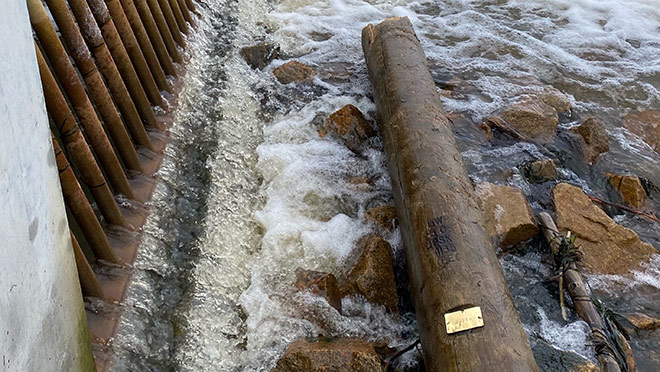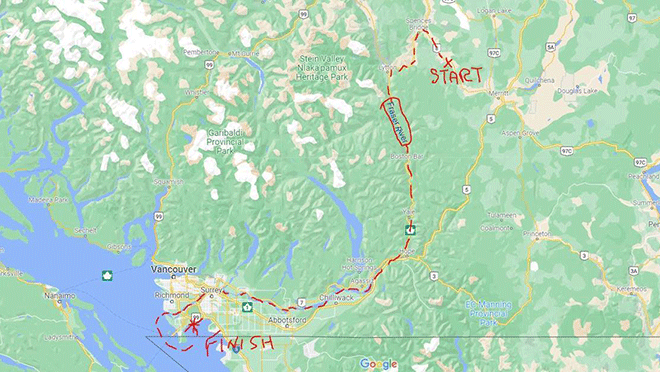How a power pole travelled hundreds of kilometres from home

Tale of the travelling power pole underlines the furious power of B.C. flooding
It came without ribbons. It did come with a tag. It came not in a package, box or bag. And she puzzled and puzzled 'till her puzzler was sore. What if this power pole came from somewhere far? What if a pole found on Christmas Day meant a little bit more? ...
Call it the perfect blend of right place, right person. And with apologies to Dr. Seuss, call it How the Pole Found Kristin.
On Christmas Day, BC Hydro human resources employee Kristin Haughian was on a family stroll along the 12th Avenue dyke in Tsawwassen when she spotted something familiar, but out of place. Bouncing on shoreline rocks, pushed up against a storm sewer on the dyke, was a big chunk of power pole, with a metal tag catching the light of the grey winter sky.
It looked like a BC Hydro pole. But what was it doing here? Haughian's husband Paul suggested it could have been a casualty of the "atmospheric river" that flooded so much of southwestern B.C. in mid-November.
"There's a line of power poles that run along the dyke, so the first thing I did when I saw the pole in the water was turn around and look at the poles behind me," recalls Haughian. "But none were missing, so we took a picture of the pole and the tag."

Database tracks each one of BC Hydro's 900,000-plus power poles
On a phone call with BC Hydro restoration operations manager Chris Walls, Haughian mentioned that she had a photo she'd like him to investigate. She knew Walls would know who to call to track the source of the pole, and that was Greg Jackson, senior field operations manager with BC Hydro's south central distribution team.
While B.C. is home to more than 900,000 BC Hydro distribution power poles – the wooden structures that support the power lines that bring electricity to homes and businesses – BC Hydro tracks and records each pole in an electronic database. Each pole has a unique metal tag attached with information that links it to a physical location along with data such as height, class, manufacturer, wood species, and treatment type.
The pole was not local. It was far from its home, a spot on Highway 8 alongside the Nicola River between Merritt and Spences Bridge. This was the twisty highway that wasn't just washed out in a few places like its big brothers such as Highway 1 and the Coquihalla. It was devastated, and a whole lot of stuff wound up in the Nicola River.
The power pole landed in that swollen river, and began an incredible journey, down the Nicola and into the Thompson River at Spences Bridge, then into the Fraser River at Lytton, and eventually, through turbulent waters including the savage currents of Hell's Gate canyon, all the way to the coast and out into the Pacific Ocean.
"It was surprising to find a pole that far away," says Jackson. "We usually find only small portions of missing poles, and they're localized piles of debris close to where they were before the flood. There are over 60 poles still unaccounted for.
"For this pole to have traveled like it did speaks to the severity of the flood event. The pole itself is broken, at probably the strongest section of the pole, which indicates the amount of force it experienced. It didn’t just fall over and gently float away."
Haughian says that while the original location of the pole was a bit of a surprise, so was its trip through international waters en route to Boundary Bay at Tsawwassen.
"It was kind of shocking to realize where the pole had actually come from," says Haughian. "And the fact that it had to go around Point Roberts and into Boundary Bay is pretty remarkable."
How BC Hydro crews restored power following November storms
There was nothing gentle about the weather that hit B.C. in November, the rising waters across southwestern B.C., and the destructive flooding that devastated Merritt, tore chunks out of major highways, and turned a huge section of low-lying Abbotsford into a lake.
Responding to the challenges of so much rain in such a short time required the help of numerous crews across BC Hydro. It wasn't easy to get crews to where they could fix damaged power lines, and road washouts and major highway closures made it difficult for line field operations to get crews and materials in and out of certain areas. But by Tuesday afternoon after the storm, which hit hardest between Saturday, November 13 and Monday, November 15, BC Hydro restored power to 219,000 customers in a 48-hour period.
Restoring power to Highway 8 remains the biggest challenge of all
The intense weather system destroyed 87 power poles and 14 transformers between Merritt and Spences Bridge. By mid-December, BC Hydro crews restored power to 70% of customers along the corridor and restoration efforts continue.
"We got power to most customers in the Highway 8 corridor restored by Christmas, but that last 20% or so is toughest," says Jackson. "It's very slow going as [B.C. highway crews] work to re-establish the road so we can put powerlines back in. Right now, there's no place to put in power lines in many places, and we can't get to those areas. It's going to be a very slow, arduous process."